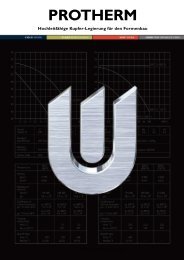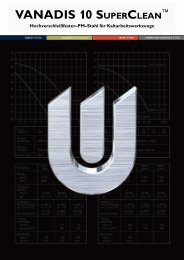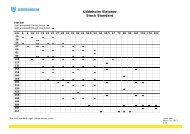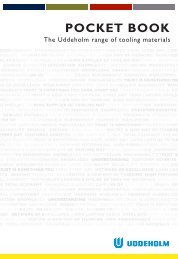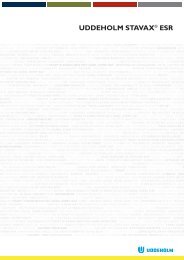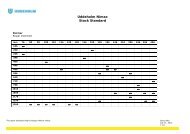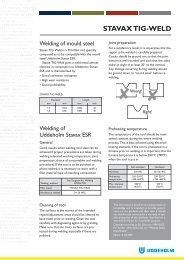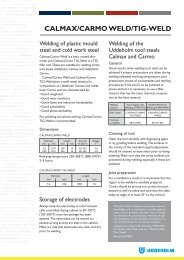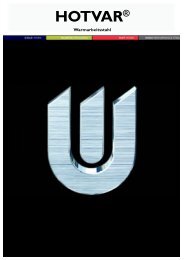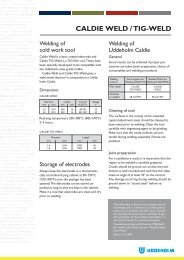Cutting data recommendations - Uddeholm
Cutting data recommendations - Uddeholm
Cutting data recommendations - Uddeholm
Create successful ePaper yourself
Turn your PDF publications into a flip-book with our unique Google optimized e-Paper software.
CUTTING DATA RECOMMENDATIONS<br />
<strong>Uddeholm</strong> Corrax<br />
Machining <strong>data</strong> are always dependent on the actual operation, the machine tool and<br />
the cutting <strong>data</strong> used. The machining <strong>data</strong> given is this <strong>data</strong>sheet are general guidelines<br />
that may have to be adjusted to the actual conditions of a specific machining operation.
Turning<br />
<strong>Cutting</strong> <strong>data</strong> formulae<br />
π ⋅ D⋅<br />
n<br />
<strong>Cutting</strong> speed, vc<br />
=<br />
1000<br />
( m /min)<br />
1000⋅<br />
vc<br />
Spindle speed, n =<br />
π ⋅ D<br />
( rev / min)<br />
Material removal rate, Q = vc<br />
⋅ ap⋅<br />
f ( cm / min)<br />
2<br />
f ⋅50<br />
Surface roughness, Ra<br />
≈ ( μ m)<br />
r<br />
ε<br />
Legend<br />
v c<br />
n<br />
f<br />
a p<br />
D<br />
Q<br />
R a<br />
r e<br />
= <strong>Cutting</strong> speed (m/min)<br />
= Spindle speed (rev/min)<br />
= Feed per rev (mm/rev)<br />
= Axial depth of cut (mm)<br />
= Workpiece diameter (mm)<br />
= Material removal rate (cm 3 /min)<br />
= Surface roughness (μm)<br />
= Nose radius (mm)<br />
Milling<br />
⋅ D ⋅ n<br />
v c = π ( m/min<br />
)<br />
1000<br />
1000 ⋅ vc<br />
n =<br />
( rev/min)<br />
π ⋅ D<br />
vf = fz ⋅ z ⋅ n=<br />
h<br />
m<br />
Q =<br />
=<br />
f<br />
z<br />
⋅<br />
ap<br />
⋅ ae<br />
⋅ v<br />
1000<br />
f<br />
f ⋅ n(mm/min )<br />
ae<br />
ae<br />
( mm ) <<br />
D D<br />
(cm<br />
3<br />
/min)<br />
0,3<br />
Legend<br />
v c<br />
n<br />
v f<br />
a p<br />
a e<br />
f<br />
z<br />
f z<br />
D<br />
h m<br />
Q<br />
= <strong>Cutting</strong> speed (m/min)<br />
= Spindle speed (rev/min)<br />
= Feed speed (mm/min)<br />
= Axial depth of cut (mm)<br />
= Radial depth of cut (mm)<br />
= Feed per rev (mm/rev)<br />
= Number of teeth<br />
= Feed per tooth (mm/tooth)<br />
= Cutter diameter (mm)<br />
= Average chip thickness (mm)<br />
= Material removal rate (cm 3 /min)<br />
Drilling<br />
π ⋅ D⋅<br />
n<br />
<strong>Cutting</strong> speed, vc<br />
=<br />
1000<br />
( m /min)<br />
1000⋅<br />
vc<br />
Spindle speed, n =<br />
π ⋅ D<br />
( rev / min)<br />
Feed speed, vf<br />
= f ⋅n<br />
( mm / min)<br />
Legend<br />
v c<br />
n<br />
v f<br />
D<br />
f<br />
= <strong>Cutting</strong> speed (m/min)<br />
= Spindle speed (rev/min)<br />
= Feed speed (mm/min)<br />
= Drill diameter (mm)<br />
= Feed per rev (mm/rev)<br />
vf<br />
Feed per rev, f = ( mm / rev)<br />
n
Turning<br />
Turning<br />
Cemented carbide<br />
HSS<br />
Roughing Finishing<br />
<strong>Cutting</strong> speed, v c (m/min) 110-160 160-210 13-18<br />
Feed, f (mm/rev) 0,2-0,4 0,05-0,2 0,05-0,3<br />
Depth of cut, a p (mm) 2-4 0,5-2 0,5-3<br />
Suitable grades P20-P30 coated carbide P10 coated carbide or<br />
cermet<br />
Remarks:<br />
1. <strong>Cutting</strong> fluid is recommended.<br />
2. For turning with interrupted cut or face turning of large workpieces use a<br />
thougher cemented carbide grade.<br />
Face milling<br />
Face milling<br />
Cemented carbide<br />
Roughing<br />
Finishing<br />
<strong>Cutting</strong> speed, v c (m/min) 70-90 90-110<br />
Feed, f z (mm/tooth) 0,2-0,4 0,1-0,2<br />
Depth of cut, a p (mm) 2-5 -2<br />
P20-P40 coated carbide P10-P20 coated carbide<br />
Suitable grades<br />
or cermet<br />
Remarks:<br />
1. Use a milling cutter with a positive-negative or positive-positive geometry.<br />
2. Climb milling should generally be used.<br />
3. Milling should generally be done with coolant.<br />
<strong>Uddeholm</strong> Corrax<br />
Square shoulder milling<br />
Square shoulder milling with cemented carbide<br />
a e = 0.1 x D a e = 0.5 x D a e = 1 x D<br />
<strong>Cutting</strong> speed, v c (m/min) 90-130 80-120 70-110<br />
Feed, f z (mm/tooth) 0,25-0,3 0,15-0,2 0,1-0,15<br />
Suitable grades P15-P40 coated carbide<br />
Remarks:<br />
1. Climb milling should generally be used.<br />
2. Choose the cutter diameter (D) and the radial depth of cut (a e ) so that at least two cutting edges<br />
are engaged simultaneously.<br />
3. If the machine tool power is inadequate for the <strong>data</strong> given reduce the depth of cut,<br />
but do not reduce the feed.<br />
2007-12-04
End milling<br />
<strong>Uddeholm</strong> Corrax<br />
Slot milling<br />
Axial depth of cut, a p = 1 x D<br />
Cutter diameter (mm)<br />
3 - 5 5 - 10 10 - 20 20 - 30 30 - 40<br />
Uncoated HSS 1-4) <strong>Cutting</strong> speed, v c (m/min) 20-25<br />
Feed, f z (mm/tooth) 0,01-0,03 0,03-0,04 0,04-0,05 0,05-0,06 0,06-0,09<br />
Coated HSS 1-4) <strong>Cutting</strong> speed, v c (m/min) 35-45<br />
Feed, f z (mm/tooth) 0,02-0,04 0,04-0,05 0,05-0,06 0,06-0,07 0,07-0,10<br />
Solid cemented <strong>Cutting</strong> speed, v c (m/min) 60-100<br />
carbide 5-8) Feed, f z (mm/tooth) 0,006-0,01 0,01-0,02 0,02-0,04<br />
Indexable insert 6-8) <strong>Cutting</strong> speed, v c (m/min) 70-110<br />
(cemented carbide Feed, f z (mm/tooth) 0,06-0,08 0,08-0,10 0,10-0,12<br />
inserts) Suitable grades P20-P30 coated carbide<br />
Side milling For side milling the same cutting speed as for slot milling can<br />
Axial depth of cut, a p = 1.5 x D be used, but the feeds must be adjusted in order to obtain a<br />
suitable average chip thickness.<br />
Correction factor for side milling<br />
Divide the cutter diameter with the radial depth of cut. See in the chart below which correction factor, C f , this<br />
corresponds to, and multiply the chosen feed in the table for slot milling with this factor.<br />
5<br />
Example:<br />
Correction factor, C f<br />
4<br />
3<br />
2<br />
1<br />
0 10 20 30 40<br />
Cutter diameter / Radial depth of cut, D/ae<br />
50<br />
Tool:<br />
CC insert<br />
Cutter diameter:<br />
D = 40 mm<br />
Radial depth of cut:<br />
a e = 2 mm<br />
D/a e = 40/2 = 20<br />
Feed acc. to table slot milling = 0.11 mm/tooth<br />
Correction factor acc. to chart: C f = 2.8<br />
Feed for side milling:<br />
f z = 2.8 x 0.11 = 0.31 mm/tooth<br />
Remarks: (slot and side milling)<br />
1. Climb milling is generally recommended.<br />
2. Use a cutter with chipbreaker when side milling with radial depths of cut, a e > 0.3 xD.<br />
3. When side milling with small radial depths of cut (a e ) the cutting speed can be increased by up to 15%.<br />
4. Use liberal amounts of cutting fluid.<br />
5. It is recommended to use a TiCN coated cutter when milling with solid cemented carbide tools.<br />
The axial depth of cut should not exceed the cutter diameter when slot milling.<br />
6. Climb milling is generally recommended.<br />
7. When side milling with small radial depths of cut (a e ) the cutting speed can be increased by up to 30%.<br />
8. The radial run-out, at the cutting edges, must be small and not exceed 0.03 mm.<br />
2007-12-04
Drilling<br />
<strong>Uddeholm</strong> Corrax<br />
Drilling<br />
Drill diameter (mm)<br />
1 - 5 5 - 10 10 - 20 20 - 30 30 - 40<br />
Uncoated HSS 1-2) <strong>Cutting</strong> speed, v c (m/min) 13-15<br />
Feed, f (mm/rev) 0,05-0,10 0,10-0,20 0,20-0,30 0,30-0,35 0,35-0,40<br />
Coated HSS 1-2) <strong>Cutting</strong> speed, v c (m/min) 13-15<br />
Feed, f (mm/rev) 0,05-0,10 0,10-0,20 0,20-0,30 0,30-0,35 0,35-0,40<br />
Indexable insert 3-4) <strong>Cutting</strong> speed, v c (m/min) 180-200<br />
(cem. carbide inserts) Feed, f (mm/rev) 0,03-0,08 0,08-0,12<br />
Solid cemented <strong>Cutting</strong> speed, v c (m/min) 100-130<br />
carbide 5-7) Feed, f (mm/rev) 0,08-0,10 0,10-0,20 0,20-0,30 0,30-0,35<br />
Brazed cemented <strong>Cutting</strong> speed, v c (m/min) 50-70<br />
carbide 5-7) Feed, f (mm/rev) 0,15-0,25 0,25-0,35 0,35-0,40<br />
Remarks:<br />
1. The cutting fluid should be ample and directed at the tool.<br />
2. When drilling with short "NC drills" the feed may be increased by up to 20%.<br />
For extra long drills the feed must be decreased.<br />
3. Use insert grades in the range of ISO P20-P30.<br />
Under unstable conditions a tougher carbide grade should be used for the centre position.<br />
4. Use a high cutting fluid pressure and flow rate for a good chip removal.<br />
5. If machining with solid or brazed cemented carbide drills, a rigid set-up and stable working conditions are required.<br />
6. The use of drills with internal cooling channels is recommended.<br />
7. Use a cutting fluid concentration of 15-20 %.<br />
Tapping with HSS<br />
<strong>Cutting</strong> speed, v c = 7-9 m/min<br />
Remarks:<br />
1. Threading compound or cutting oil gives a longer tool life than emulsion.<br />
2007-12-04



